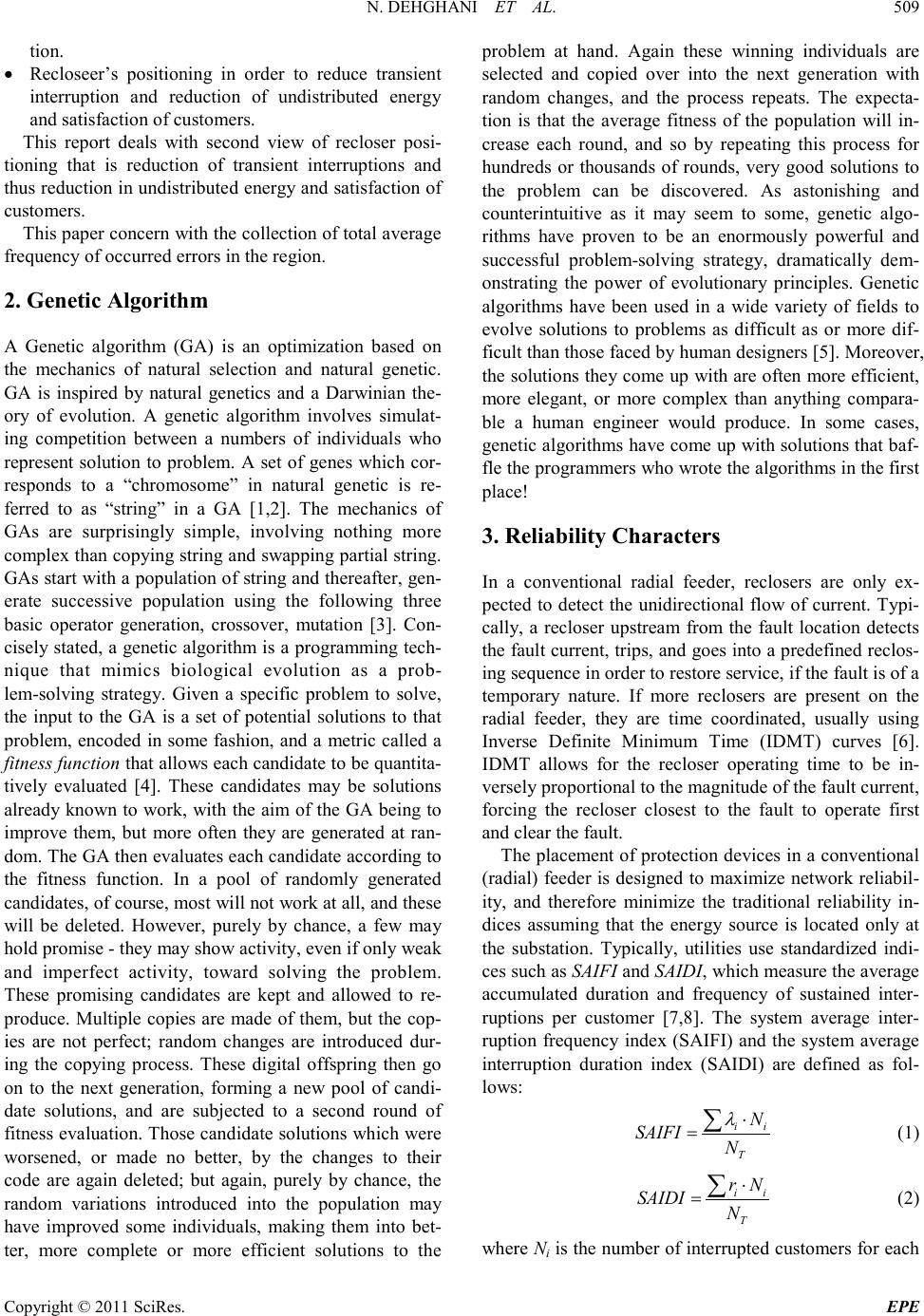
N. DEHGHANI ET AL.
Copyright © 2011 SciRes. EPE
tion.
• Recloseer’s positioning in order to reduce transient
interruption and reduction of undistributed energy
and satisfaction of customers.
This report deals with second view of recloser posi-
tioning that is reduction of transient interruptions and
thus reduction in undistributed energy and satisfaction of
customers .
This paper concern with the collection of total average
frequency of occurred errors in the region.
2. Genetic Algorithm
A Genetic algorithm (GA) is an optimization based on
the mechanics of natural selection and natural genetic.
GA is inspired by natural genetics and a Darwinian the-
ory of evolution. A genetic algorithm involves simulat-
ing competition between a numbers of individuals who
represent solution to problem. A set of genes which cor-
responds to a “chromosome” in natural genetic is re-
ferred to as “string” in a GA [1,2]. The mechanics of
GAs are surprisingly simple, involving nothing more
complex than copying string and swapping partial string.
GAs start with a population of string and thereafter, gen-
erate successive population using the following three
basic operator generation, crossover, mutation [3]. Con-
cisely stated, a genetic algorithm is a programming tech-
nique that mimics biological evolution as a prob-
lem-solving strategy. Given a specific problem to solve,
the input to the GA is a set of potential solutions to that
problem, encoded in some fashion, and a metric called a
fitness function that allows each candidate to be quantita-
tively evaluated [4]. These candidates may be solutions
already known to work, with the aim of the GA being to
improve them, but more often they are generated at ran-
dom. The GA then evaluates each candidate according to
the fitness function. In a pool of randomly generated
candidates, of course, most will not work at all, and these
will be deleted. However, purely by chance, a few may
hold promise - they may show activity, even if only weak
and imperfect activity, toward solving the problem.
These promising candidates are kept and allowed to re-
produce. Multiple copies are made of them, but the cop-
ies are not perfect; random changes are introduced dur-
ing the copying process. These digital offspring then go
on to the next generation, forming a new pool of candi-
date solutions, and are subjected to a second round of
fitness evaluation. Those candidate solutions which were
worsened, or made no better, by the changes to their
code are again deleted; but again, purely by chance, the
random variations introduced into the population may
have improved some individuals, making them into bet-
ter, more complete or more efficient solutions to the
problem at hand. Again these winning individuals are
selected and copied over into the next generation with
random changes, and the process repeats. The expecta-
tion is that the average fitness of the population will in-
crease each round, and so by repeating this process for
hundreds or thousands of rounds, very good solutions to
the problem can be discovered. As astonishing and
counterintuitive as it may seem to some, genetic algo-
rithms have proven to be an enormously powerful and
successful problem-solving strategy, dramatically dem-
onstrating the power of evolutionary principles. Genetic
algorithms have been used in a wide variety of fields to
evolve solutions to problems as difficult as or more dif-
ficult than those faced by human designers [5]. Moreover,
the solutions they come up with are often more efficient,
more elegant, or more complex than anything compara-
ble a human engineer would produce. In some cases,
genetic algorithms have come up with solutions that baf-
fle the programmers who wrote the algorithms in the first
place!
3. Reliability Characters
In a conventional radial feeder, reclosers are only ex-
pected to detect the unidirectional flow of current. Typi-
cally, a recloser upstream from the fault location detects
the fault current, trips, and goes into a predefined reclos-
ing sequence in order to restore service, if the fault is of a
temporary nature. If more reclosers are present on the
radial feeder, they are time coordinated, usually using
Inverse Definite Minimum Time (IDMT) curves [6].
IDMT allows for the recloser operating time to be in-
versely proportional to the magnitude of the fault current,
forcing the recloser closest to the fault to operate first
and clear the fault.
The placement of protection devices in a conventional
(radial) feeder is designed to maximize network reliabil-
ity, and therefore minimize the traditional reliability in-
dices assuming that the energy source is located only at
the substation. Typically, utilities use standardized indi-
ces such as SAIFI and SAIDI, which measure the average
accumulated duration and frequency of sustained inter-
ruptions per customer [7,8]. The system average inter-
ruption frequency index (SAIFI) and the system average
interruption duration index (SAIDI) are defined as fol-
lows:
T
N
SAIFI N
λ
⋅
=
(1)
(2)
where Ni is the number of interrupted customers for each